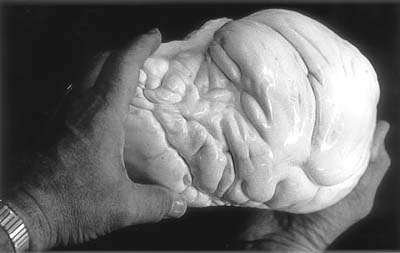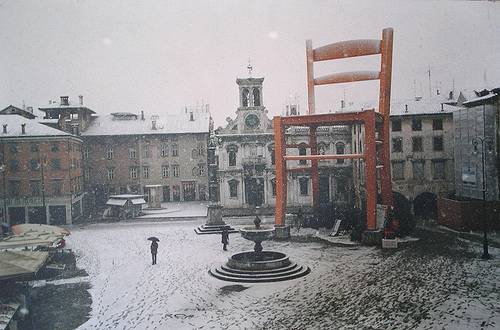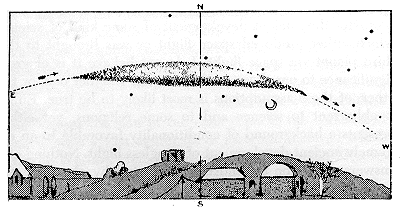
An optical illusion. Nothing’s actually moving.

An optical illusion. Nothing’s actually moving.

Account of strange electrical activity during a blizzard at Bar Harbor, Maine, from the Ellsworth Herald, March 4, 1853:
Mrs. E. Holden was near a window, winding up a clock; a ball of fire came in through the window and struck her hand, which benumbed her hand and arm. She then, with all in the house, retreated into the entry. Another flash succeeded, and, in the room from which they had retired, resembled [sic] a volume of fire, whirling around and producing a cracking noise. A similar appearance of fire was seen, and cracking noises were heard in a large number of houses. Some who heard the noise say it sounded like breaking glass.
Capt. Maurice Rich had his light extinguished, and his wife was injured. He got his wife onto a bed and found a match; at that instant another flash came and ignited the match and threw him several feet backwards. John L. Martin received such a shock that he could not speak for a long time.
A great many people were slightly injured. Some were struck in the feet, some in the eye while others were electrized [sic], some powerfully and some slightly. But what was very singular, not a person was killed or seriously injured, not a building damaged; but a cluster of trees within a few rods of two dwelling houses was not thus fortunate. The electric fluid came down among them, taking them out by the roots, with stones and earth, and throwing all in every direction. Some were left hanging by their roots from the tops of adjacent standing trees — roots up, tops down.
The New York Times later quoted a witness: “I don’t believe there ever was a worse frightened lot of people in the world than the inhabitants of Bar Harbor were that night. That purple ball [of] lightning flashed about and obtruded itself everywhere. There was scarsely [sic] a house that was not visited by it.”
On Sept. 22, 1979, a U.S. satellite spotted a flash of light in the Indian Ocean. The satellite was designed to detect nuclear explosions, but unfortunately it was failing, so we can’t be sure what it saw.
What caused the flash? Possibilities include a nuclear test by South Africa or Israel; a meteor entering the atmosphere; a French neutron bomb; or even a meteor striking the satellite itself. For now, no one knows.

“The pearl is the oyster’s autobiography,” said Fellini.
In this case it’s an epic: The Pearl of Lao Tzu weighs 31,893 carats, or more than 14 pounds.
It was extracted from a giant clam in the Philippines in 1934.
A tombstone in the island of Jamaica has the following inscription: ‘Here lieth the body of Lewis Galdy, Esq., who died on the 22d of September, 1737, aged 80. He was born at Montpellier, in France, which place he left for his religion, and settled on this island, where, in the great earthquake, 1672, he was swallowed up, and by the wonderful providence of God, by a second shock was thrown out into the sea, where he continued swimming until he was taken up by a boat, and thus miraculously preserved. He afterwards lived in great reputation, and died universally lamented.’
— Frank H. Stauffer, The Queer, the Quaint and the Quizzical, 1882

This is not Photoshopped — it’s an actual photograph of the world’s largest chair, in the piazza of Manzano, Italy, where it was dedicated. (Manzano is a city of chair makers.)
Photographer Rob Krause says, “They’re still working on the table.”
Two months ago an unmanned catamaran appeared near Australia’s Great Barrier Reef. The Kaz II had set out safely from nearby Airlie Beach four days earlier. Her engine was running, and her radio and navigation system were working. The sails were up, though one was badly shredded. Survival equipment, including three life jackets and an emergency beacon, were found on board. Investigators even found a laptop running and the table laid for dinner. But the three-man crew were nowhere to be found.
A search was called off after two days. That’s all anyone knows.

On Nov. 17, 1882, something odd appeared in the sky over Europe. The “strange celestial visitor” appeared low in the northeastern sky and elongated as it moved steadily from east to west over the course of two minutes. It was whitish or greenish-white, about 30 degrees long and 3 degrees wide, and had distinct edges.
Whatever it was, the thing was witnessed by professional astronomers across the continent and described in journals including Nature and The Observatory. Edward Walter Maunder of the Greenwich Royal Observatory said it moved “as the Sun, Moon, stars and planets move but nearly a thousand times as quickly.” Even 34 years later Maunder recalled the phenomenon as “unlike any other celestial object that I have ever seen. The quality of its light, and its occurrence while a great magnetic storm and a bright aurora were in progress, seem to establish its auroral origin. But it differed very widely in appearance from any other aurora that I have ever seen.”
What was it? No one knows.

‘A fellow, a shepherd at Beverley, in Yorkshire, about eleven years ago, for a bet of five pounds, was produced, who was to devour a living cat. The one produced was a large black tom cat, which had not been fed for the purpose; but was chosen, as being the largest in that neighbourhood. The day appointed was the fair-day at Beverley. The parties met. The man produced was a raw-boned fellow, about forty. The cat was then given to him; on which he took hold of his four legs with one hand, and closing his mouth with the other, he killed him by biting his head to pieces immediately, and in less than a quarter of an hour, devoured every part of the cat, tail, legs, claws, bones, and every thing. The man who laid the wager gave the fellow two guineas for doing it, and the shepherd appeared perfectly satisfied with the reward.’
— The Cabinet of Curiosities, 1824
‘At Stramore, in the county of Monaghan, near the town of Glaslough,’ say the newspapers of 1813, ‘a short time ago a quantity of butter was found in a bog on the lands of Thomas Johnson, of Armagh, Esq. at the depth of twenty feet beneath the surface of the ground. In consequence of the antiseptic qualities of the bog, the butter was found in a state of the most perfect preservation; its colour a statuary white. The person who found this butter mixed it with other unctuous matter, and formed it into candles for family use. It was more condensed in substance than butter usually is, but perfectly sweet in taste, and free from any disagreeable odour.’
— The Cabinet of Curiosities, 1824